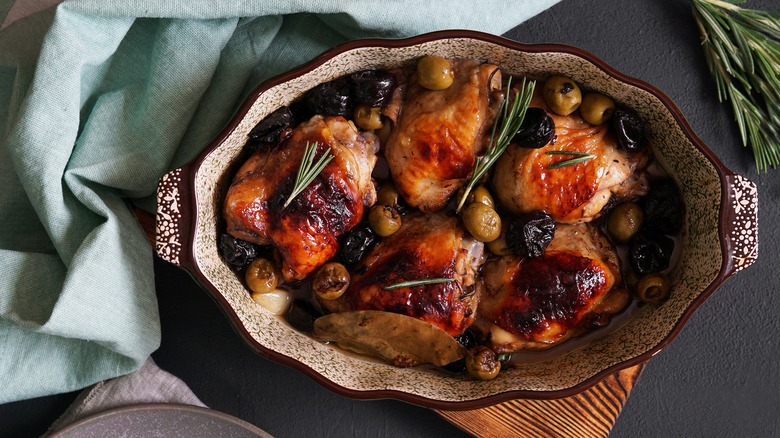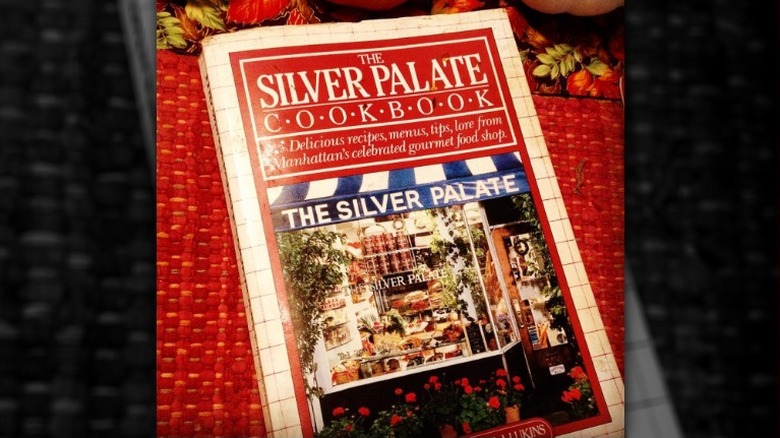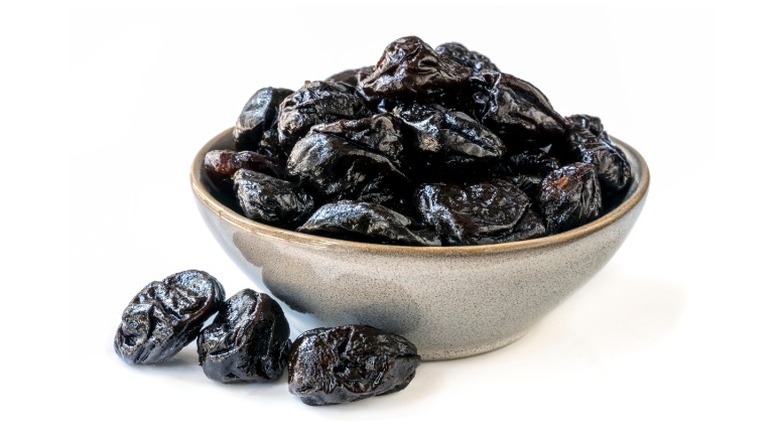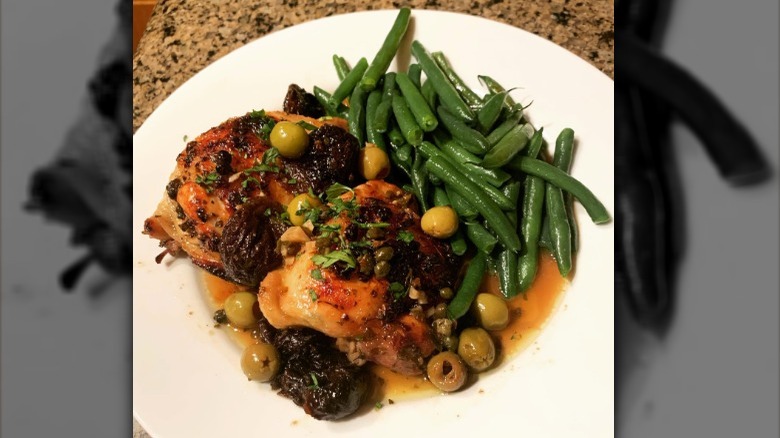What Is Chicken Marbella And What Is The Most Unusual Ingredient?
Near the southern tip of Spain lies the coastal town of Marbella, a sun-soaked, posh playground that caters to the super-rich. This fantasyland of beaches, yachts, and five-star resorts has Michelin-starred restaurants and wonderful seafood dishes, but not chicken Marbella. Despite the name, chicken Marbella is a creation from 1970s New York City while the name is actually a nod to the ingredients and the influence the Mediterranean country had on the dish's creator.
Since its inception, chicken Marbella has had a particularly loyal fanbase amongst Jewish Americans, but the fact it can be made ahead of time make it a great dish for large gatherings and parties while the complex layers of flavors appeal to many people. Chicken Marbella begins by marinating a chicken in a mixture of olive oil, vinegar, herbs, and spices for 24 hours before the chicken is roasted in the oven with the marinade, wine, and brown sugar. But the element that catches most people's eye when they are introduced to the dish is the addition of a rather unconventional ingredient: a dried fruit that most people snack on rather than cook with.
Two women and a gourmet food shop
Chicken Marbella entered the New York food scene thanks to Sheila Lukins and Julee Rosso. The pair met in New York City when Rosso hired Lukins to cater a party. The two immediately hit it off and opened up The Silver Palate in 1977, a small take-out shop. Initially, the shop offered only a few entrees, including chicken Marbella, which was an immediate customer favorite. By the time the 1980s rolled around, The Silver Palate had become a wild success and the two women released The Silver Palate cookbook in 1982, which featured the popular recipe.
The Silver Palate cookbook offered readers approachable recipes for Mediterranean, Spanish, and Asian cuisine, and it was on these pages that the nation was introduced to (and fell in love with) chicken Marbella. The recipe originally came from Lukin who was heavily influenced by the dishes she had while traveling in Spain and northern Africa; you can see both regions represented in the dish. To the author's surprise, it has also become a Jewish go-to dish. Although Jewish herself, Lukin never intended chicken Marbella to be a dish for Jewish holiday meals, but nevertheless it has become a staple for many Jewish families and perhaps was even subconsciously influenced by Lukin's heritage as the combination of meat and dried fruit is common in Sephardic Jewish cuisine and other Jewish dishes like the Ashkenazi Jewish stew tzimmes.
How chicken Marbella is made and the surprising fruit on the ingredient list
The original recipe from The Silver Palate instructs readers to marinate quartered chickens in olive oil, red wine vinegar, green olives, capers, garlic, bay leaves, oregano, and — drumroll, please — prunes! Rosso and Lukins' recipe pulls from a variety of international cuisines and techniques, and it's this globe-trotting sensibility that's responsible for what might be a surprising mix of flavors and the distinctive ingredient prunes.
Julee Rosso told Tablet that the inclusion of green olives is reminiscent of places like Marbella, Spain where meat dishes are often combined with the briny treats. And those surprising prunes? They're pulled from North Africa, specifically Morocco, where a signature style of cooking sees different kinds of meats braised with dried fruits in tagines. Francophile cooks might also recognize prunes as a staple of French cooking; in fact, chicken Marbella is similar to a classic French dish called lapin aux pruneaux, in which rabbit is braised in prunes.
After this international marinade is assembled, the chicken is left in the refrigerator to soak in the mixture for 24 hours. When it's ready to cook, the chicken pieces are placed in a baking dish or roasting pan with the marinade and white wine. Brown sugar is sprinkled on top of the chicken and the pan is roasted for about an hour. Finally, the chicken pieces are served with the marinade, fruits, and olives poured over top.
The result is a savory, sweet, and tangy dish, which can be served hot or at room temperature; some recipes even claim that chicken Marbella tastes better the day after it's cooked as the flavors will have had time to concentrate.
When is chicken Marbella served?
Perhaps the real question is when can't you serve chicken Marbella? The dish is simple enough for a midweek meal, but also special enough for company. Admittedly, some of the ingredients are polarizing — the olives and prunes, particularly — so a crowd with an open mind would be ideal.
As mentioned above, Jewish holiday meals regularly feature the dish. Perhaps because of its similarity to other Jewish recipes and ingredient combinations, chicken Marbella has been a staple on many Shabbat tables since its origin. Not only are the ingredients tied to Jewish cuisine, but the preparation makes it ideal for large family gatherings like Seder dinner. Passover is an important holiday and event for practicing Jews and there is a lot of preparation to do, so if the main course can be assembled the day before and popped in the oven on the day of, all the better.
Still, anyone with an adventurous palate can enjoy chicken Marbella for holidays, potlucks, picnics, birthdays, or just Tuesday night dinner. Like many chicken entrees, it is excellent served with a starch on the side like roasted potatoes, pasta or rice, and a green vegetable.
Although less trendy than it was in previous decades, chicken Marbella is a classic example of how some dishes that take the nation by storm are so good that they simply never go out of style.



